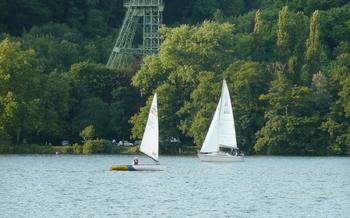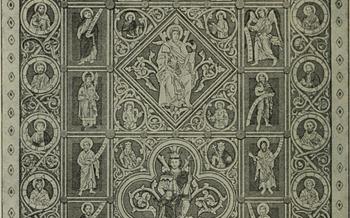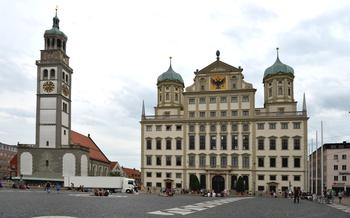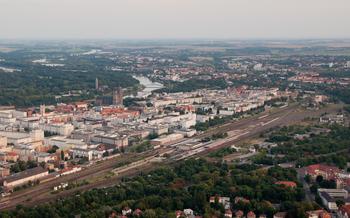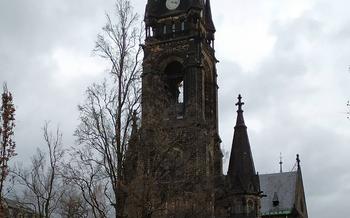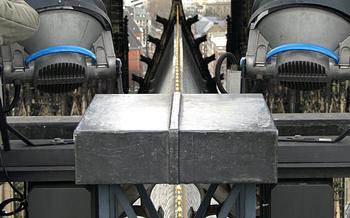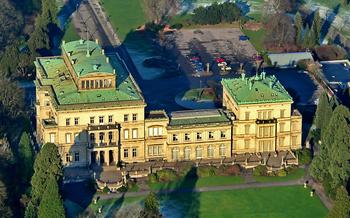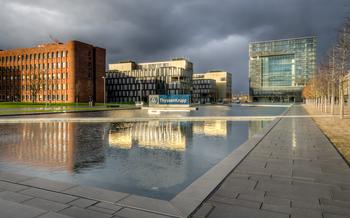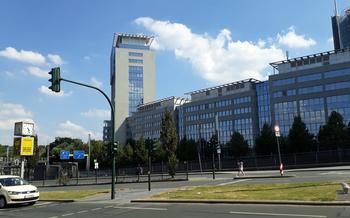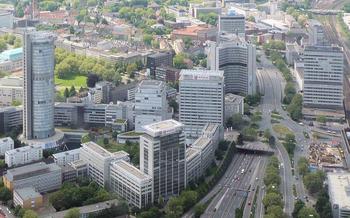
Essen Abbey
- Historical Significance
- Architectural Masterpiece
- Treasury of Art
- Witness to History
- UNESCO World Heritage Site
- Guided Tours
- Events and Exhibitions
- Pilgrimage Site
- Museum of Sacred Art
- Nearby Attractions:
- Opening Hours and Admission
- Accessibility
- Photography and Videography
- Dress Code
- Insider Tip: Essener Münstertage (Essen Abbey Days)
Historical Significance
The Essen Abbey, a majestic architectural wonder in the heart of Essen, Germany, holds a rich and profound historical significance. Its origins can be traced back to the 9th century, when it was founded by Saint Altfrid, a respected missionary and abbot. During the Middle Ages, the Abbey flourished as an Imperial Abbey, enjoying the patronage and protection of the Holy Roman Emperors. This elevated status granted the Abbey considerable influence and autonomy, allowing it to amass vast wealth and contribute significantly to the cultural and intellectual landscape of the region.
Architectural Masterpiece
The Essen Abbey stands as a testament to the architectural brilliance of the Romanesque and Gothic periods. Its imposing structure, adorned with intricate carvings and sculptures, reflects the artistry and devotion of its builders. The exterior showcases magnificent stonework, with elaborate portals and decorative arcades. Inside, the Abbey's soaring columns, ribbed vaults, and graceful arches create a sense of awe and wonder. Detailed reliefs and sculptures depict biblical scenes and saints, narrating the stories of faith and devotion. The stunning stained glass windows, crafted with vibrant colors and intricate designs, bathe the interior in a ethereal light, transforming the Abbey into a sanctuary of beauty and spirituality. Explore the Abbey's architectural wonders, and marvel at the craftsmanship that has stood the test of time.
Treasury of Art
The Essen Abbey boasts an exceptional collection of medieval artwork, a true testament to the artistic prowess of the era. Among the highlights are the exquisite works of renowned goldsmiths, including the Essen Cross, a masterpiece of Ottonian art crafted from gold, silver, and precious stones. The abbey also houses an impressive collection of reliquaries, adorned with intricate carvings and gemstones, serving as elaborate containers for the relics of saints. Liturgical objects, such as chalices, monstrances, and crosiers, further enhance the abbey's treasury, showcasing the exceptional craftsmanship and devotion of medieval artisans.
Witness to History
The Essen Abbey has witnessed many significant historical events throughout its existence. During the Saxon and Salian dynasties, it played a crucial role as a center of power and influence. The Abbey's abbots were often appointed as imperial advisors and held considerable political sway.
The Protestant Reformation had a profound impact on the Abbey. In 1543, the city of Essen embraced Lutheranism, and the Abbey was forced to adapt to the new religious landscape. Although the Abbey remained a Catholic institution, it was forced to cede some of its lands and privileges to the Protestant city council.
In 1803, the Abbey was secularized as part of the Napoleonic Wars. It was transformed into a collegiate church and lost its status as an independent religious institution. However, the Abbey's rich artistic and cultural heritage remained intact, and it continued to serve as a place of worship and pilgrimage.
UNESCO World Heritage Site
Essen Abbey's exceptional cultural value has been recognized by UNESCO, earning it the prestigious designation of a World Heritage Site. This accolade places the Abbey among the most significant cultural landmarks in the world, alongside renowned monuments such as the Great Wall of China and the Taj Mahal. Inclusion on the World Heritage List signifies the Abbey's outstanding universal value and its importance in preserving and showcasing the cultural heritage of humanity. UNESCO's recognition underscores the Abbey's exceptional architecture, its rich history, and its enduring significance as a spiritual and cultural center.
The Abbey's designation as a World Heritage Site not only brings international recognition but also ensures its ongoing protection and preservation. UNESCO's rigorous standards and guidelines require the Abbey to be managed and maintained in a way that respects its historical and cultural significance. This includes measures to safeguard the Abbey's structural integrity, protect its unique features, and promote sustainable tourism practices.
As a visitor to Essen Abbey, you can contribute to its preservation by adhering to the guidelines and regulations set forth by UNESCO and the Abbey's administration. By respecting the Abbey's sanctity and treating its artifacts and surroundings with care, you can help ensure that this extraordinary heritage site continues to inspire and awe generations to come.
Guided Tours
Enhance your visit to Essen Abbey with a guided tour, available in multiple languages. Knowledgeable guides will lead you through the Abbey's intricate architecture, sharing captivating stories and insights into its rich history. Immerse yourself in the tales of Saint Altfrid, the medieval Imperial Abbey, and the Abbey's role during significant historical periods.
Advance booking is recommended to secure your spot, especially during peak tourist seasons. Check the Abbey's website for available tour times and languages. Group discounts and specialized tours for students or specific interests may also be available.
Don't miss this opportunity to delve deeper into the fascinating world of Essen Abbey, where history, art, and spirituality intertwine. Let the expert guides unveil the secrets and significance of this architectural masterpiece, leaving you with a profound understanding and appreciation for its enduring legacy.
Events and Exhibitions
The Essen Abbey is not just a historical site but also a vibrant cultural hub. Throughout the year, the Abbey hosts a variety of events, concerts, and exhibitions that showcase local talent and promote cultural exchange. These events provide an opportunity to experience the Abbey's rich history and heritage in new and engaging ways.
From classical music concerts to contemporary art exhibitions, there's something for everyone at the Essen Abbey. The Abbey's acoustics make it an ideal venue for musical performances, and the stunning architecture provides a breathtaking backdrop for artistic displays.
To stay updated on upcoming events, check the Abbey's website or follow their social media pages. Advance booking is recommended for popular events to avoid disappointment.
Here are some of the highlights:
-
The annual "Essener Münstertage" (Essen Abbey Days) is a week-long festival celebrating the Abbey's rich history and cultural significance. During this festival, the Abbey comes alive with special events, guided tours, exhibitions, and performances.
-
The Essen Abbey Music Festival features a series of concerts performed by renowned musicians from around the world. The festival showcases a diverse range of musical genres, from classical and sacred music to jazz and contemporary compositions.
-
The Abbey also hosts regular art exhibitions, showcasing the works of local and international artists. These exhibitions provide a platform for emerging artists to showcase their talent and for visitors to discover new and exciting contemporary art.
Pilgrimage Site
Essen Abbey has served as a significant pilgrimage site for centuries, attracting devout visitors from across the region and beyond. The Abbey is particularly known for its association with Saint Altfrid, a revered figure who played a pivotal role in the Abbey's founding and early development. Pilgrims come to venerate Saint Altfrid and other saints associated with the Abbey, seeking spiritual guidance and inspiration. The Abbey's serene and contemplative atmosphere provides a conducive environment for reflection, prayer, and a deeper connection with one's faith.
Museum of Sacred Art
Nestled within the historic walls of Essen Abbey, the Museum of Sacred Art invites visitors on a journey through centuries of religious expression and artistic mastery. Housing an extensive collection of artifacts and artworks, the museum showcases the rich heritage of the Abbey and its profound influence on the region's cultural landscape.
From intricately carved sculptures to awe-inspiring paintings, the museum's exhibits span the Middle Ages to the present day. Visitors can admire the delicate craftsmanship of goldsmiths, marvel at the vibrant colors of stained glass windows, and explore the symbolism embedded in religious iconography. Interactive displays and multimedia presentations further enhance the experience, providing a deeper understanding of the Abbey's history and the significance of its artistic treasures.
Whether you're a devout pilgrim, an art enthusiast, or simply curious about the spiritual legacy of Essen, the Museum of Sacred Art offers a unique and enriching experience. Take your time to wander through the galleries, immerse yourself in the beauty of the exhibits, and discover the profound connection between art and faith that has shaped the soul of this remarkable Abbey.
Nearby Attractions:
Complement your visit to Essen Abbey by exploring other cultural and historical gems in the city. The Ruhr Museum showcases the region's industrial heritage and boasts a vast collection of art and artifacts. Admire the grandeur of Villa Hügel, a magnificent estate that once belonged to the Krupp family, a prominent industrial dynasty. Delve into the history of coal mining at the Zollverein Coal Mine Industrial Complex, a UNESCO World Heritage Site. Combine these attractions with your Abbey visit to create a well-rounded itinerary that immerses you in Essen's rich cultural tapestry.
Opening Hours and Admission
Before embarking on your journey to Essen Abbey, it's essential to familiarize yourself with its opening hours and admission procedures. While the Abbey generally welcomes visitors throughout the week, it's advisable to verify its current operating hours to avoid any inconvenience. This information can be easily obtained from the Abbey's official website or by contacting their friendly staff.
Admission to the Abbey is typically subject to a modest fee, which contributes to the preservation and maintenance of this magnificent heritage site. For a seamless experience, consider purchasing your tickets online in advance, ensuring your entry without any delays. Alternatively, tickets can be purchased at the Abbey's entrance, providing flexibility for spontaneous visits.
Remember that the Abbey may occasionally experience closures or changes in its operating hours during public holidays or special events. To avoid disappointment, it's recommended to check for any such deviations before finalizing your travel plans.
Accessibility
The Essen Abbey is committed to ensuring that all visitors, regardless of their abilities, can fully enjoy and appreciate its beauty and history. Wheelchair accessibility is a priority, with designated parking spaces available for those who require them. The Abbey's staff is also available to provide assistance to visitors with disabilities, making sure their visit is as comfortable and enjoyable as possible. To ensure a smooth and seamless experience, it is advisable to contact the Abbey in advance if you have any specific accessibility needs or concerns. They will be more than happy to assist you in planning your visit and making any necessary arrangements.
Photography and Videography
Photography and videography are generally permitted within the Abbey, allowing visitors to capture the stunning architecture, intricate carvings, and beautiful stained glass windows. However, it is important to be mindful of the solemnity of the space and avoid using flash photography, as it can be disruptive to other visitors and worshippers.
When taking photographs or videos, be respectful of the privacy of others and avoid capturing people in a way that they may find intrusive. It is also important to be aware of any signs or notices within the Abbey that may restrict photography or videography in certain areas.
By following these guidelines, visitors can document their visit to Essen Abbey while respecting the sacred nature of the space. The resulting images and videos can serve as cherished mementos of a visit to this remarkable historical and cultural landmark.
Dress Code
While visiting Essen Abbey, it is important to respect the religious significance of the site by dressing appropriately. While there is no strict dress code, it is recommended to opt for modest attire. Avoid wearing shorts, tank tops, or revealing clothing that might be deemed disrespectful in a sacred space. Dressing respectfully not only shows your consideration for the Abbey's religious significance but also creates a more somber and reflective atmosphere for all visitors.
Insider Tip: Essener Münstertage (Essen Abbey Days)
Immerse yourself in the vibrant atmosphere of the annual "Essener Münstertage" (Essen Abbey Days), a unique opportunity to experience the Abbey's rich history and cultural significance. Held over several days, this festival features a captivating array of events, guided tours, and immersive experiences that bring the Abbey's past to life. Explore hidden corners of the Abbey, listen to captivating stories from expert guides, and participate in interactive workshops that delve into the Abbey's artistic treasures. Whether you're a history buff, an art enthusiast, or simply seeking a unique and enriching experience, the Essener Münstertage is an event not to be missed. Check the Abbey's website for dates and details to plan your visit accordingly and make the most of this extraordinary festival.
